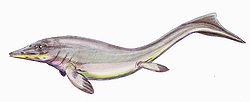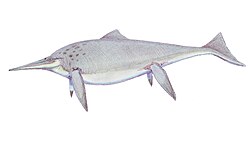| Sumpalla Temporal range: | |
|---|---|
 | |
| Speculative life restoration | |
| Scientific classification | |
| Kingdom: | Animalia |
| Phylum: | Chordata |
| Class: | Reptilia |
| Order: | † Ichthyosauria |
| Family: | † Ophthalmosauridae |
| Subfamily: | † Platypterygiinae |
| Genus: | † Sumpalla Campos et al., 2021 |
| Species: | †S. argentina |
| Binomial name | |
| †Sumpalla argentina Campos et al., 2021 | |
Sumpalla is an extinct genus of ophthalmosaurid ichthyosaurs from the Late Jurassic Vaca Muerta Formation of Argentina. It contains a single species, Sumpalla argentina. The holotype was initially believed to have belonged to Aegirosaurus before being placed in a new genus in 2021. [1]







